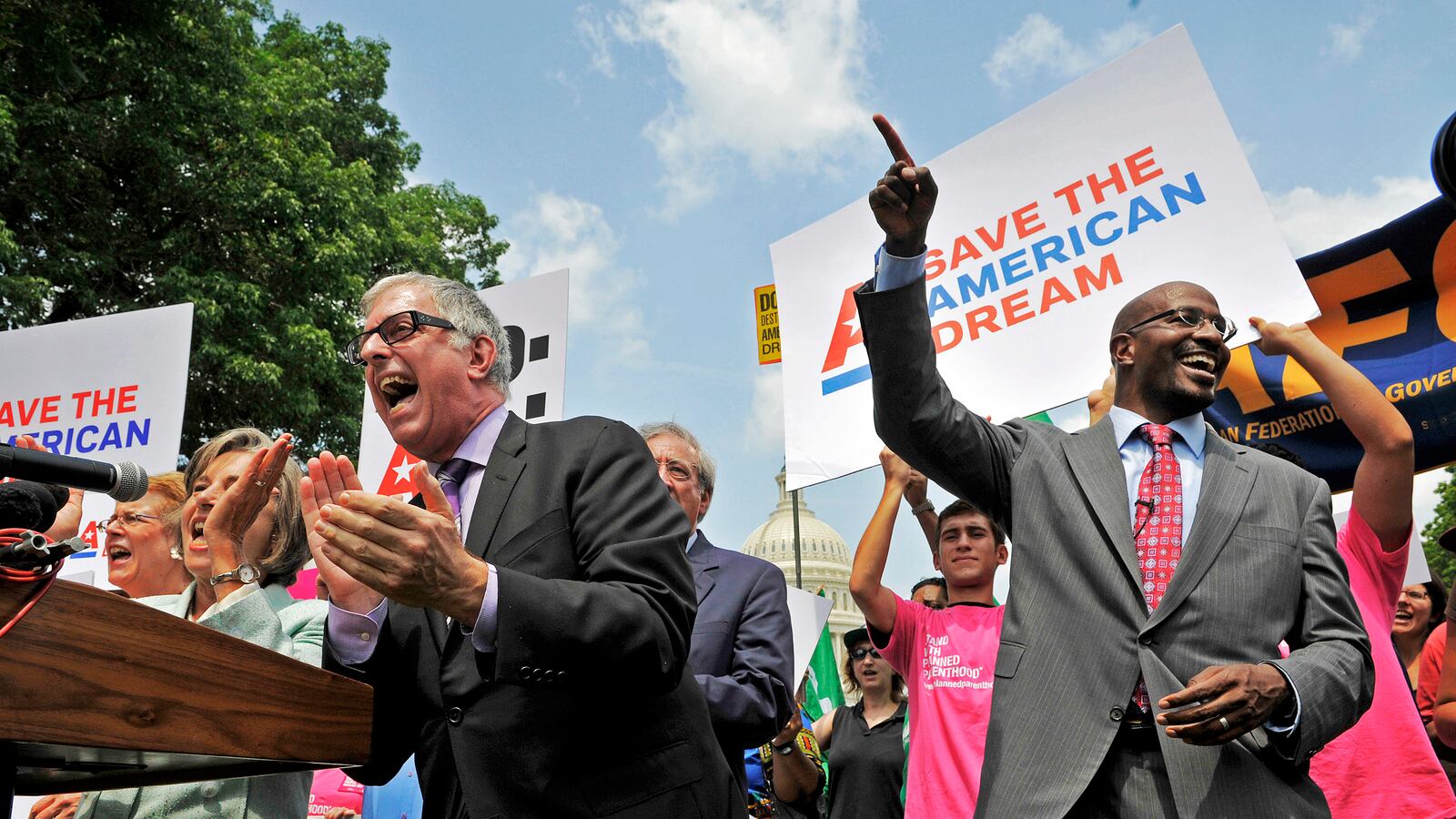Van Jones is sitting in an office in Washington, D.C., talking about John McCain when, quite unexpectedly, he starts crying.
He’d been discussing the shock of some in the Obama administration at the furious right-wing backlash that greeted their arrival in Washington, a backlash that hit Jones particularly hard. “We thought John McCain was the representative of the Republican Party,” he says. “John McCain, who we didn’t like and didn’t agree with, but who, at the end of the day, put country first.”
Jones recalled an angry McCain town hall in Minneapolis where attendees voiced their mounting contempt for Obama. At one point, an older women had declared that Obama was an untrustworthy “Arab.” Shaking his head, McCain took the microphone from her and replied, “No, ma’am. He’s a decent family man.” That moment moved Jones. “He stood up, two weeks before the election,” he says. “Down in the polls. Needing his base. That’s a big deal.” His voice cracks as he continues. “And it was the people in the audience that disrespect this country. And they’ve taken over this party. And they’re trying to take over America.” He bangs on the table. “And we can’t let them!”
Tears start running down his face and his voice catches in a sob. It could be an act for dramatic emphasis, but it sure doesn’t seem like it. “I’m telling you, this country is better than this,” he says. “This is the low point. Hang on. Help is on the way.”
By “help,” Jones means his new American Dream Movement, which he envisions as a left-wing alternative to the Tea Party. Launched at a July 23 event in New York City that was part rally, party dance party, the American Dream Movement aims to restore the fight for economic justice to the center of progressive politics. On Aug. 9, the movement put out its crowd-sourced “Contract for the American Dream,” a 10-point economic manifesto that called for new investments in education and infrastructure; higher taxes for corporations, Wall Street and the wealthy; and curbs on lobbyists. The next day, it was published as a full-page ad in The New York Times. Democratic Rep. Jan Schakowsky of Illinois will soon introduce the Emergency Jobs to Restore the American Dream Act, legislation based on the document.

Jones is convinced that with the right message and the right organizing, the now-dissipated energy of the Obama campaign can be recaptured. Speaking of progressive disappointment with the president, he holds up a sheet of paper. “It’s that thin,” he says. “People forgot that our slogan was not ‘Yes he can.’ It was ‘Yes we can.’ The minute we have a vehicle to be ‘we’ again, a lot of this stuff goes away.”
People who expect Obama to lead progressives, he says, misunderstand his role, and their own. “The job of leading an independent movement to bring out the best in our country is not the same job as being head of state,” he says. “I’m glad [Obama] is there, and I will do everything in my power to make sure he stays head of state until they have to pull him out of there. I might block the driveway at the end of 2016. But the job of creating an independent movement that brings out the best in the American people, that’s our job.”
There’s a certain dramatic symmetry in Jones’ quest to take on the Tea Party. After all, when he resigned his position as White House special adviser for green jobs in September 2009, he became one of the nascent movement’s first scalps. He retains a central place in Tea Party demonology, his name often mentioned in the same breath as George Soros and Saul Alinsky. Meanwhile, for progressives, his exit was an early warning of the right-wing ferocity to come, and of Obama’s disinclination to fight back. He’s a living symbol of our current political polarization.
Despite his pugnacity, it’s an odd role for Jones. Like Obama, he was once seen as a consensus-building figure, a man who had disavowed his youthful radicalism in favor of a pro-market commitment to wedding environmentalism and inner-city job creation. California Republican Meg Whitman had declared herself a “huge fan” of his. Thomas Friedman wrote an admiring column about him.
But to Glenn Beck and other fervid Obama opponents, Jones quickly came to represent all that was alarming about the new administration. The conservative media painted him as a subversive and a thug. Jones had once been caught up in a mass arrest while acting as a legal observer at a San Francisco march against the Rodney King verdict. Charges were dropped, and he was compensated for unjust arrest. On Beck’s show, that incident was transmuted into a lengthy prison sentence for rioting. “He spent six months in jail, came out a communist,” Beck warned his viewers. “And then he decided—he found the eco-movement—and decided green is the new red.”
Still, Jones was ultimately the victim of a self-inflicted wound. At the height of the campaign against him, it came out that he’d allowed his name to be used on a 9/11 Truth petition. (He insists he hadn’t read it, and had simply agreed to lend his support to a call to help 9/11 families.) After that, his resignation was probably inevitable. It’s not surprising, though, that he was left feeling bruised. “We came to this town with our arms wide open, in the middle of the biggest economic crisis since the Great Depression, expecting to find a partner on the other side,” he says. “And we got kicked in the teeth.”
For a while, he faded from view, teaching at Princeton and making a careful study of modern political movements, including the Tea Party. The American Dream Movement is the distillation of what he has learned.
Like the Tea Party, the American Dream Movement is intended to be open-source, meaning that all sorts of different groups planning all sorts of different actions are encouraged to unite under its banner. But it will also have an umbrella organization, called Rebuild the Dream, which Jones is creating in concert with MoveOn.org. “If the American Dream Movement is the Tea Party, then Rebuild the Dream is Americans for Prosperity or the Tea Party Express,” says Justin Ruben, MoveOn’s executive director.
That’s not the only parallel. The American Dream Movement is intended to put a name on a preexisting political force, just as the Tea Party did. Part of the inspiration for the movement came from the demonstrations against right-wing economic policies in Wisconsin and Ohio. Since then, there have been protests nationwide, some in unexpected places. In April, Montana saw one of its biggest rallies ever when 1,500 people gathered in front of the capitol to protest budget cuts. In July, 800 people demonstrated on behalf of public-school teachers in Ogden, Utah. These protests have received far less attention than the Tea Party. “There’s been an unprecedented wave of activity that’s had no common banner, and so nobody noticed,” says Ruben.
Of course, ever since the Tea Party emerged on the scene, progressives have been trying to create its left-wing analogue. Last year saw the formation of the Coffee Party and the One Nation march, neither of which amounted to much. Judson Philips, founder of Tea Party Nation, scoffs at the notion that his movement can be replicated. “Do you want my reaction before or after I stop laughing?” he says. Of course, his dismissal of Jones rests on a distorted idea of who Jones is. “I know he’s basically a Marxist who doesn’t like this country,” he says. “If he had his way, American would look like the old Soviet Union.”
This misses the ardent patriotism that courses through Jones’ rhetoric. “We like the Tea Party’s patriotism,” he says. “We like their love of liberty. But we think they don’t embrace the full set of American values. The pledge of allegiance doesn’t end with the word ‘liberty.’ It ends with ‘liberty and justice for all.’ That’s a much more robust concept of what America is.”
Rep. Keith Ellison, co-chair of the House Progressive Caucus and an admirer of Jones, believes that, like the Obama campaign, the American Dream Movement can succeed by combining a commitment to intensive organizing with a deep faith in American exceptionalism. “I’m so glad that he has clearly recognized that we as progressives cannot concede patriotic themes to the right wing,” says Ellison. “Why would we ever do that? Everything we love about this country—the right to vote, equality before the law, the right to organize—these things were won by patriotic Americans.” Members of the Tea Party, he says, “wrap themselves in the flag, but they’re not upholding core American values. We are.”
On July 28, about 400 people showed up on Capitol Hill on a viciously hot day to protest the budget cuts being proposed as part of the debt-ceiling negotiations. Eight members of Congress spoke, including Ellison and Reps. Donna Edwards and Jerry Nadler. It didn’t get as much press as the Tea Party rally held in the same place the previous day, which drew only 50 people. Still, a battery of TV cameras turned out, and Jones, astonishingly crisp in a gray three-piece suit, felt victorious. “This is the beginning of something,” he says with a certainty that’s infectious, whether or not it’s warranted. “You can tell your grandkids you were here.”






